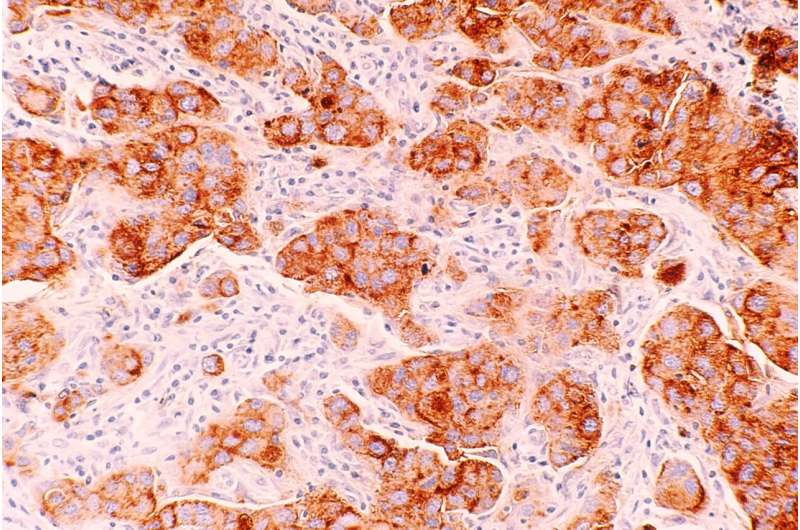
Second-line treatment with trastuzumab deruxtecan (T-DXd) led to significantly longer overall survival compared with trastuzumab emtansine (T-DM1) in patients with HER2-positive metastatic breast cancer, according to updated results from the DESTINY-Breast03 phase III clinical trial presented at the San Antonio Breast Cancer Symposium, held December 6-10, 2022.
“Almost all patients with HER2-positive metastatic breast cancer experience disease progression on first-line treatment, requiring transition to a second-line treatment,” said Sara Hurvitz, MD, a professor of medicine at the David Geffen School of Medicine at the University of California Los Angeles and Jonsson Comprehensive Cancer Center.
Two antibody-drug conjugates, T-DXd and T-DM1, are approved as second-line treatment for this patient population. Both therapies utilize trastuzumab to seek HER2-expressing cells and deliver a cytotoxic drug. In the case of T-DXd, the cytotoxic payload induces cell death by inhibiting topoisomerase; the conjugated drug of T-DM1 kills cells by disrupting microtubule assembly.
The DESTINY-Breast03 trial compared the efficacy and safety of T-DXd with those of T-DM1 in patients with HER2-positive metastatic breast cancer that progressed on or after first-line treatment. Previously published interim results from the trial demonstrated that patients treated with T-DXd had significantly longer progression-free survival (PFS) compared with patients who received T-DM1. These results led to the approval of T-DXd as a second-line treatment for this patient population. However, overall survival data had not been reached in the first interim analysis.
“While PFS benefits are important, the gold standard measure of efficacy is overall survival,” said Hurvitz.
In her presentation, Hurvitz will share previously unreported overall survival data from the trial, as well as updated PFS and safety data. Among the 524 patients enrolled in the trial, 261 received T-DXd, and 263 received T-DM1. The median study follow-up was 28.4 months for the T-DXd arm and 26.5 months for the T-DM1 arm.
New data showed that patients treated with T-DXd had a 36 percent lower risk of death than those treated with T-DM1, a statistically significant improvement. In addition, overall survival rates were significantly higher for patients treated with T-DXd: After 12 months, 94.1 percent of patients in the T-DXd arm were alive, compared with 86 percent of those in the T-DM1 arm. After 24 months, overall survival rates were 77.4 percent and 69.9 percent for patients treated with T-DXd and T-DM1, respectively.
Updated PFS data continued to favor T-DXd, and Hurvitz will report median values for the first time. The median PFS in patients treated with T-DXd was 28.8 months, compared with 6.8 months for patients treated with T-DM1. Objective responses were observed in 78.5 percent of patients who received T-DXd and 35 percent of patients treated with T-DM1. Furthermore, 21.1 percent of patients treated with T-DXd had a complete response, as compared with 9.5 percent of patients treated with T-DM1.
Grade 3 or higher treatment-related adverse events were observed in 56.4 percent and 51.7 percent of patients in the T-DXd and T-DM1 arms, respectively. Drug-related interstitial lung disease/pneumonitis was observed in 15.2 percent and 3.1 percent of patients in the T-DXd and T-DM1 arms, respectively. Hurvitz noted that new cases of interstitial lung disease/pneumonitis were mild or moderate in severity.
“The results of this analysis demonstrated remarkable overall survival and continued PFS benefit with T-DXd in patients with HER2-positive metastatic breast cancer who progressed on prior therapy, further supporting the use of T-DXd over T-DM1 in the second-line setting,” said Hurvitz. “With this overall survival analysis, we can confirm that the previously demonstrated benefit from T-DXd in PFS improvement transforms into a statistically significant improvement in overall survival, a substantial advantage for our patients.
“In addition, T-DXd continued to demonstrate a manageable and tolerable safety profile, with similar rates of treatment-related adverse events between treatment arms,” she added.
Future analyses of DESTINY-Breast03 may investigate the efficacy of T-DXd in patients with brain metastases and explore predictive markers of response, Hurvitz noted. Ongoing studies aim to determine the efficacy and safety of T-DXd as a first-line treatment for patients with HER2-positive metastatic breast cancer.
A limitation of the study was the disproportionate enrollment of Asian patients as compared with North American and European patients. An additional limitation was that median overall survival was not reached at the time of this analysis.
More information:
Conference: www.sabcs.org/
Source: Read Full Article
